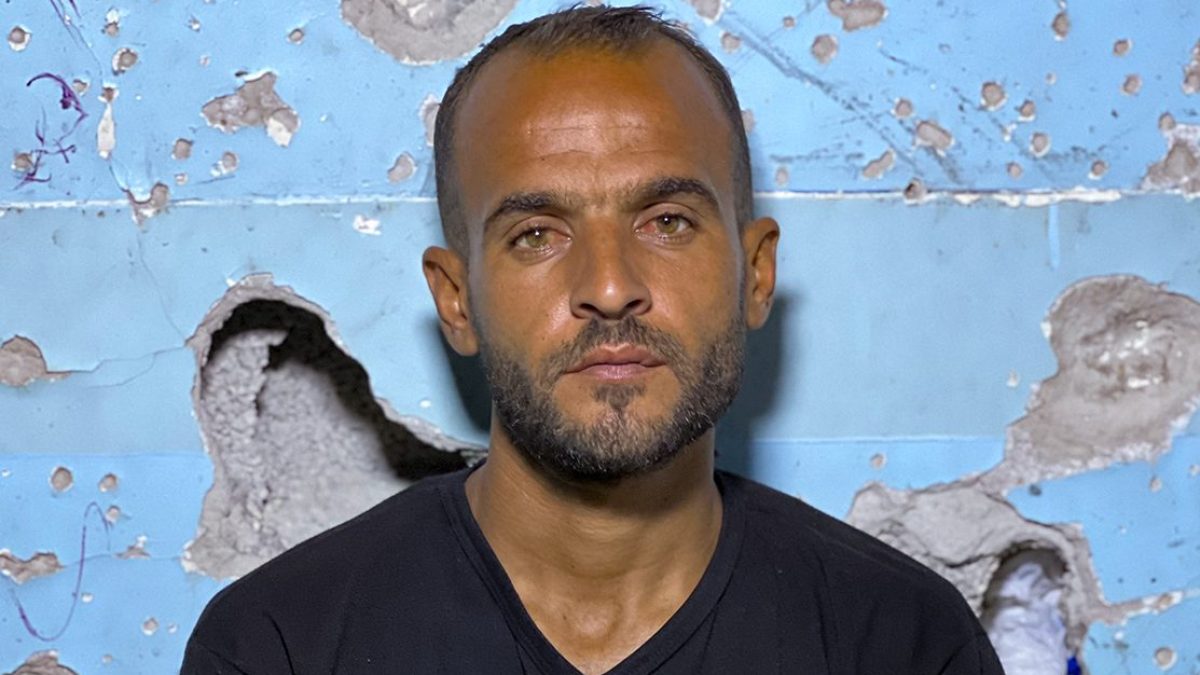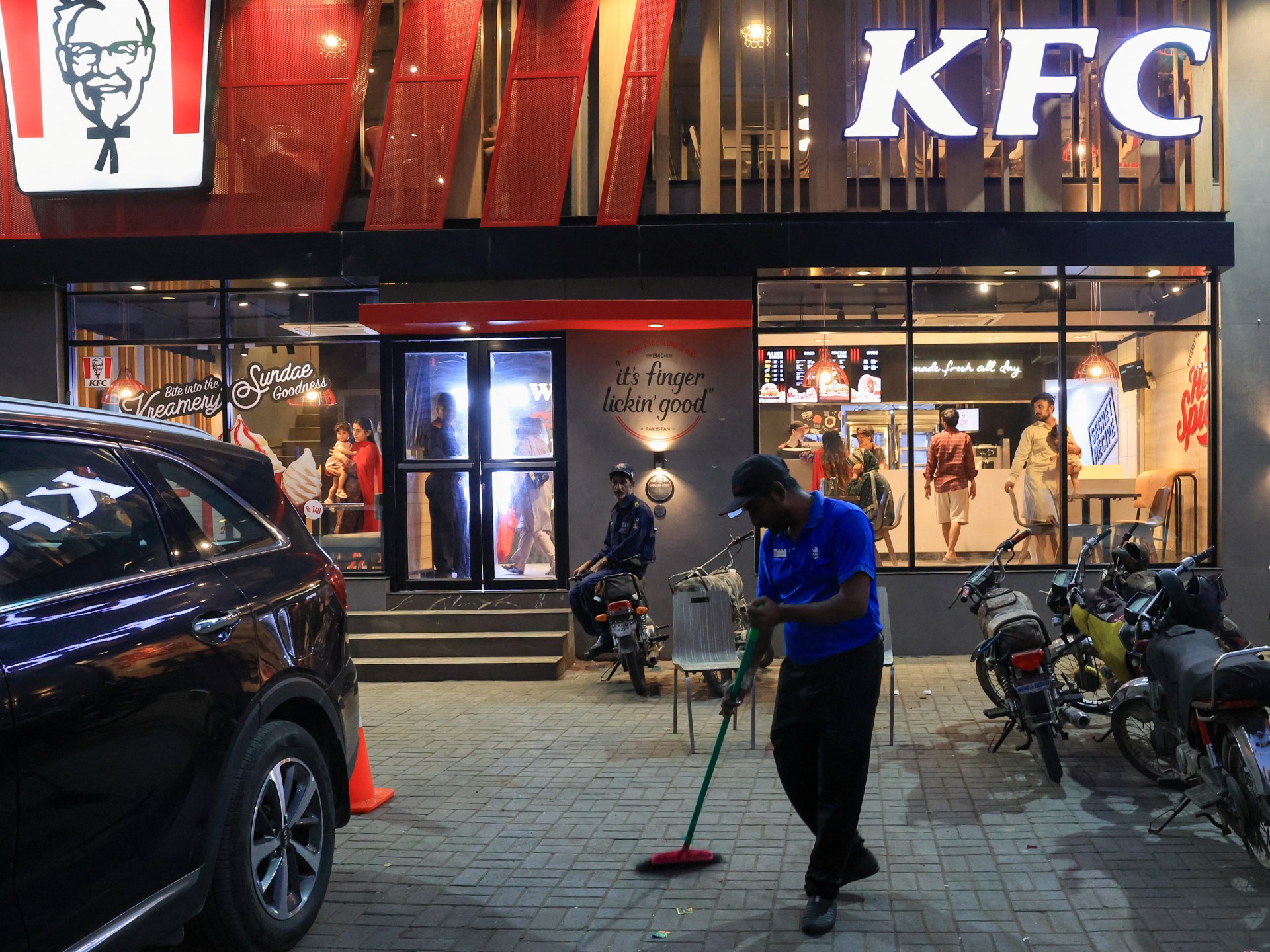Middle East
‘I was a human shield’: What Israeli soldiers did to a Gaza father | Israel-Palestine conflict News

Gaza City – On October 19, hundreds of displaced Palestinians in northern Gaza’s Hamad School in Beit Lahiya heard what everyone in the Palestinian enclave dreads.
“At dawn, we heard [Israeli] tanks encircling the school, and quadcopters overhead began ordering everyone to get out,” Amal al-Masri, 30, who had given birth to her youngest daughter so recently she had not named her yet when the tanks came, recalled.
People were already tense after shelling and explosions throughout the night – the adults too scared to sleep, the children crying in fear and confusion.
“Buildings were being shelled all around us,” said Amal, who lived in a ground- floor classroom with her husband Yousef, 36, their five young children – Tala, Honda, Assad, and Omar, all aged between four and 11, and Yousef’s 62-year-old father Jamil.
Amal had cradled the baby while Yousef held two of their youngest children. Together, the adults had prayed.
Now, it was dawn, and a recording of a male voice speaking in Arabic played through loudspeakers on a quadcopter circling over the school, ordering everyone to come out with their IDs and hands up.
The quadcopter shot at the buildings and dropped sound bombs, sending people into a panic as they rushed to gather whatever they could. Some fled with nothing.
Yousef, Amal and the children were among the first to get to the schoolyard – Yousef and the four children held up their IDs and their hands, while Amal held the baby in her arms.
In the chaos, Yousef lost track of his father.
“The quadcopters instructed: ‘Men to the school gate, women and children in the schoolyard,’” Amal recalled.
The pit
“There were soldiers at the school gate with tanks behind them, and more soldiers surrounding the place,” Yousef said.
He and other males aged more than 14 years, including some he recognised from nearby schools, were ordered by Israeli soldiers to gather at the main gate in groups, line up and approach an inspection passage with a camera, known as “al-Halaba”.
“Each man was ordered to approach a board with a camera on it, one by one,” explains Yousef, who thinks the camera used facial recognition technology.
After being registered by the camera, the man or boy was sent to a pit dug by Israeli bulldozers, he says.
Over the next few hours, some males were released, others were sent to another pit, while some were interrogated.
As for Yousef, he knelt with about 100 other men in a pit near the school with his hands behind his back all day.

“The soldiers were shooting, throwing sound bombs, beating some of the men, torturing others,” he said. Throughout, he worried about his family.
“I was deeply worried about my wife and children. I didn’t know anything about them,” Yousef recounted. “My wife had given birth a week ago and she wouldn’t be able to walk with the children. Without anyone to help, I was afraid of what might happen to them.”
When evening came, there were only about seven men left in the pit.
Yousef was hungry, tired and worried, then a soldier pointed at him. “He randomly chose me and two other men; we didn’t understand why,” Yousef told Al Jazeera.
“The soldiers took us to an apartment in a nearby building,” he said, adding that he thinks they were near the Sheikh Zayed roundabout.
The men were forbidden from speaking to each other, but Yousef had recognised them – a 58-year-old and a 20-year-old who were sheltering in schools near Hamad. Throughout, he said, the sound of shelling and bombing echoed around them.
“A soldier told us we’d be helping them with some missions and would be released after, but I was afraid they’d kill us at any moment,” Yousef said.
‘Using me for cover’
Yousef and his exhausted fellow captives dozed off at some point in the night, before being jolted awake by the soldiers and pushed out of the apartment and into the streets.
He soon realised that the soldiers were walking behind him, to use him as cover.
“The realisation that I was being used as a human shield was terrifying.”
When they reached a school that had been emptied by Israeli soldiers, he was ordered to open doors and go into each classroom to check for fighters who might be hidden there.
The heavily armed soldiers would only enter after his “all clear”.
The day continued that way, with Yousef being used to “clear” room after room, after which the soldiers would set the buildings on fire.
The whole time, Yousef feared a quadcopter would shoot him, or an Israeli sniper might mistake him for a threat and kill him.
When the day’s searches were complete, he was brought back to the apartment with the two other men and given the second meal of the day, a piece of bread and some water, just like the morning.
On the fourth day, Yousef and the 58-year-old man were ordered to go to a nearby school and the Kamal Adwan Hospital to deliver evacuation leaflets to people sheltering there.
They were given an hour and told that a quadcopter would be hovering overhead. As they handed the leaflets to people, quadcopters were announcing the evacuation over loudspeakers.
Escape
Yousef decided he would try to escape that day by hiding in the hospital courtyard.
“I was afraid to go back,” he explained. “I wanted to escape and find out if my family was safe, as I had overheard soldiers instructing women and children to head south to Khan Younis.”
He decided to get in a line of men being forced to evacuate, waiting anxiously as time dragged on. The soldiers had said they should only be gone for an hour, and it had been several.
The line of men was advancing. “I was praying they wouldn’t recognise me,” Yousef said.
Then a soldier sitting atop a tank shot him in the left leg.
“I fell to the ground. The men around tried to help me, but the soldiers shouted at them to leave me,” Yousef recalls.
“I clung to one of the men, then a soldier said to me, scolding: ‘Come on, get up and lean on this man and head to Salah al-Din Street.’”
Despite the pain as he hobbled away, Yousef was in disbelief that the soldier had not killed him. “I expected to be killed at any moment,” he said.
A little further on, he was taken by a Palestinian ambulance to al-Ahli Arab Hospital for treatment.

Reuniting
Amal, who had taken the children to the New Gaza School in al-Nasr in the west of Gaza City, heard one day that Yousef was at al-Ahli Hospital.
She rushed there, relieved after having suffered through days of conflicting reports as some people said they saw him detained, while others said they had seen him elsewhere.
She had barely made it to al-Nasr, she told Al Jazeera over the phone.
On the day the family was separated, she says, the women and children were kept in the schoolyard for hours.
“My children were terrified. Many kids were crying. Some were asking for food, water. Mothers pleaded with soldiers for food and water, but they just yelled at us and refused.”
In the afternoon, the Israeli soldiers moved the women and children to a checkpoint with a camera.
“They told us to walk out five at a time,” Amal said, describing how her 11-year-old daughter Tala was held back to join the group after her.
“She started crying and calling, ‘Mama, please don’t leave me,’” Amal recounts, her voice shaking.
They were eventually told to walk south on Salah al-Din Street.
“The tanks surrounding the school were overwhelming – I thought to myself: ‘God! A whole brigade of tanks has come for these defenceless civilians.’
“My body was exhausted – I had given birth only a week earlier, and I could barely carry my baby, much less the few belongings we had.”
As tanks rumbled around them, they kicked up waves of dust and sand. “With all the dust, I stumbled, and my baby girl fell from my arms onto the ground,” Amal recalls, telling how she screamed and the older children cried when the baby fell.
Eventually, she left all their belongings on the road; she was too weary to keep carrying them. She needed to get her children somewhere safe.
“My four-year-old son didn’t stop crying: ‘I’m tired, I can’t do it.’ We had no food, no water, nothing.”
Early in the evening, she reached New Gaza School with other displaced people from the north.
Amal, Yousef, and their children are together now, in a classroom at the school.
Yousef spent two days in the hospital and, after 13 stitches, walks cautiously with a limp.
Yousef’s father Jamil has been missing since the day the soldiers came to Hamad School. He heard from some people that his father had been taken prisoner, but he does not know.
Their baby daughter, unnamed when they were forced to leave northern Gaza, has been named Sumoud, “steadfastness”, a symbol of their refusal to leave.
Middle East
Iran says progress in nuclear talks with US, confirms third round next week | News

After technical talks, senior negotiators expected to reunite on April 26, according to Iran’s foreign ministry.
Iran and the United States have completed a second round of indirect nuclear negotiations, which Iran’s foreign minister has described as “constructive” and moving forward with further meetings planned in the coming week.
Abbas Araghchi and US Middle East envoy Steve Witkoff held four hours of indirect talks at Oman’s embassy in the Italian capital, Rome, on Saturday, according to Araghchi.
“We succeeded in reaching a better understanding on certain principles and goals,” the diplomat was quoted by the semiofficial Tasnim news agency as saying. “The negotiations were conducted in a constructive atmosphere and are progressing.”
There has been no readout yet of the meeting from the US side.
The delegations – led by Araghchi and Witkoff, a billionaire real estate executive whom US President Donald Trump has dispatched on numerous foreign policy missions – stayed in separate rooms in the embassy as Omani Foreign Minister Badr al-Busaidi shuttled messages between them, according to Iranian officials.
Iran’s Ministry of Foreign Affairs said the parties will hold more indirect, technical-level talks in the coming days, followed by another meeting with senior officials on April 26.
There were useful indirect talks today between Iran and the United States conducted by Oman Foreign Minister in a constructive atmosphere.
The two sides agreed to continue the indirect talks in few days at technical level to be followed by another round at their own level on…
— Esmaeil Baqaei (@IRIMFA_SPOX) April 19, 2025
“I hope that after next week’s technical sessions, we’ll be in a better position,” Araghchi said, according to Tasnim. “There’s no reason for excessive optimism or pessimism.”
‘Negotiations to pick up’
Al Jazeera’s James Bays, reporting near the Omani diplomatic compound in Rome, said the Iranian response was “very positive” for a delegation that “had seemed pretty negative going into the talks”.
Next week’s planned talks mean “the pace of negotiations is going to be picked up”, Bays said.
The latest meeting comes a week after Iran and the US came together in Muscat for their first high-level discussions since Trump in 2018 unilaterally abandoned a landmark nuclear accord signed and brokered by world powers in 2015.
The Iranians “are looking for a kind of consistency when it comes to the current talks”, Al Jazeera’s Tohid Asadi reported from Tehran.
Will US accept civilian nuclear programme?
Western governments, including the US, have long accused Iran of seeking to develop nuclear weapons – an allegation Tehran has denied, insisting its nuclear programme is solely for peaceful civilian use. On Wednesday, the head of the International Atomic Energy Agency, Rafael Grossi, said Iran was “not far” from possessing a nuclear weapon.
Grossi was also in Rome on Saturday meeting Italian Foreign Minister Antonio Tajani. Grossi’s nuclear watchdog would likely be central in verifying compliance by Iran should a deal be reached, as it did with the 2015 accord.
The US and Iran have had no diplomatic relations since shortly after Iran’s 1979 Islamic Revolution. After returning to office in January, Trump revived his “maximum pressure” sanctions campaign against Tehran, but in March, he sent a letter to Iranian Supreme Leader Ali Khamenei calling for renewed negotiations – while warning of military consequences if diplomacy fails.
“I’m not in a rush” to use force, Trump said on Thursday. “I think Iran wants to talk.”
On Friday, Araghchi said the US showed “a degree of seriousness” during the first round of talks but questioned Washington’s “intentions and motivations”.
Bays said the heart of the dispute remains whether Iran may maintain a civilian nuclear programme – or whether, as hardliners in Washington insist, it must dismantle its nuclear programme entirely.
“All they’ve been talking about last week in Muscat and here in Rome is a framework for the discussions and what they want to achieve,” Bays said. “They have not been discussing the nuclear detail, … and the devil is in the detail on these things.”
Middle East
Over 170 arrested for attacks on Pakistan KFC outlets in Gaza war protests | Israel-Palestine conflict News

Western brands have been hit by boycotts and other forms of protests in Muslim-majority countries due to the Gaza war.
Police have arrested close to 200 people in Pakistan in recent weeks after more than 10 group attacks on outlets of the United States-based fast-food chain KFC, sparked by anti-US sentiment, unconditional US backing for Washington’s close ally Israel and opposition to Israel’s war in Gaza, officials say.
The fast-food chain has become a target of protest and boycott calls by Islamist parties since the start of the war in Gaza as they link the brand to US support for Israel.
At least 178 people have been arrested, the officials said this week.
Police in major cities in Pakistan – including the southern port city of Karachi, the eastern city of Lahore and the capital, Islamabad – confirmed at least 11 incidents in which KFC chicken restaurants were attacked by protesters armed with sticks and vandalised.
A police official, who spoke on condition of anonymity, said one KFC employee was shot and killed this week in a store on the outskirts of Lahore by unknown gunmen. The official added there was no protest at the time and police were investigating whether the killing was politically motivated or for some other reason.
In Lahore, police said they were ramping up security at 27 KFC outlets after two attacks took place and five were prevented.
“We are investigating the role of different individuals and groups in these attacks,” Faisal Kamran, a senior Lahore police officer told the Reuters news agency, adding that 11 people, including a member of the Islamist party Tehreek-e-Labbaik Pakistan (TLP), have been arrested in the city. He added the protests were not officially organised by the TLP.
TLP spokesman Rehan Mohsin Khan said the group “has urged Muslims to boycott Israeli products, but it has not given any call for protest outside KFC”.
“If any other person claiming to be a TLP leader or activist has indulged in such activity, it should be taken as his personal act which has nothing to do with the party’s policy,” Khan said.
Western brands have been hit by boycotts and other forms of protests in Pakistan, other Muslim-majority countries and several Western nations over Israel’s military offensive in the Gaza Strip.
In February last year, McDonald’s cited boycott campaigns in the Middle East, Indonesia and Malaysia for sales growing just 0.7 percent during the fourth quarter of 2023, compared with 16.5 percent growth in the same quarter the previous year.
Unilever – which produces Dove soap, Ben & Jerry’s ice cream and Knorr stock cubes – also said sales in Indonesia in the same quarter had experienced a double-digit decline as a result of “geopolitically focused, consumer-facing campaigns”.
A KFC restaurant in the Pakistan-administered region of Kashmir was also set on fire in March last year as protesters chanted “Free Palestine.”
More than 51,900 people have been killed in Gaza during Israel’s war, which began 18 months ago.
At least 1,139 people were killed in Israel during the Hamas-led attacks of October 7, 2023, and more than 200 were taken captive.
KFC and its parent company Yum Brands have not yet responded to news of the arrests in Pakistan.
Middle East
Israeli bombardment of Gaza kills 92 in two days: Health Ministry | Israel-Palestine conflict News
At least 219 people have also been injured in attacks since Good Friday, with many children among the casualties, according to health officials.
Israeli attacks have killed 92 Palestinians in the Gaza Strip over the past two days, according to the territory’s Ministry of Health.
The attacks, which took place on April 17-19, have also left at least 219 people wounded and hospitalised, the ministry said in a statement on Saturday, with dozens more still trapped under the rubble or in areas that rescuers are unable to reach.
The surge in bloodshed comes as Israel presses a six-week aid blockade and demands that Hamas disarm before any truce can be agreed. The armed group has flatly refused the demand and insists a permanent ceasefire must be part of any deal.
At least 15 children, hit during an overnight air raid on tents in Khan Younis, were among the casualties, according to the statement. A raid on Rafah killed a mother and her daughter alongside two others, according to the European Hospital where their bodies were taken.
“For the vast majority of civilians, nighttime is the time of horror and unrelenting pain,” said Al Jazeera’s Tareq Abu Azzoum, reporting from central Gaza. “Nobody is safe in their homes, in the makeshift tents, in displacement camps.”

‘Less than a meal a day’
After restarting its military campaign on March 18 following a brief ceasefire, Israel has pledged to intensify its 18-month war on Gaza and occupy large “security zones” inside the Strip.
Since March 2, it has also blocked the entry of food, fuel and aid into the enclave, defying an order by the International Court of Justice (ICJ) that it must allow humanitarian access.
Aid groups warn food is running out.
“Kids are eating less than a meal a day and struggling to find their next meal,” said Bushra Khalidi, policy head of Oxfam. “Malnutrition and pockets of famine are definitely occurring in Gaza.”
Earlier this week, Hamas rejected an Israeli proposal to pause fighting for 45 days if the Palestinian group releases 10 live captives and agrees to disarm.
“The request to disarm Hamas is not acceptable to even hear,” senior Hamas official Sami Abu Zuhri said. “This is not just a red line. It is a million red lines.”
Hamas has offered to free all remaining captives – believed to be about 58 although several are dead – in return for a permanent end to the war and the Israeli army’s full withdrawal.
The death toll in Gaza has now reached 51,065, with 116,505 wounded, according to the Health Ministry.
“We can see the very psychological toll in the city on the faces of everyone here, people are walking very exhausted, traumatised,” said Abu Azzoum. “They are thinking about the dark future that awaits them.”
-

 Education1 day ago
Education1 day agoHarvard’s battle with the Trump administration is creating a thorny financial situation
-

 Conflict Zones1 day ago
Conflict Zones1 day agoTrump says US may ‘pass’ on helping end war if Russia, Ukraine resist deal | Russia-Ukraine war News
-

 Sports1 day ago
Sports1 day agoManchester United pulls off ‘miracle’ Europa League victory against Lyon
-

 Africa1 day ago
Africa1 day agoTrump administration plans to shut down nearly 30 U.S. embassies — over half in Africa
-

 Sports1 day ago
Sports1 day agoAaron Rodgers ‘not holding anybody hostage’ as he decides his future, retirement a possibility
-

 Lifestyle2 days ago
Lifestyle2 days agoFans of Superman relate to comic’s religious and ethical themes
-

 Europe2 days ago
Europe2 days agoLive updates: Trump news, Ukraine peace talks, US immigration, tariffs and university funding
-

 Sports2 days ago
Sports2 days agoNY Rangers’ Panarin, MSG reportedly made settlement payments after employee made sexual assault allegations




